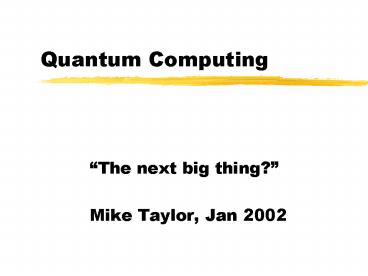Quantum Computing PowerPoint PPT Presentation
1 / 10
Title: Quantum Computing
1
Quantum Computing
- The next big thing?
- Mike Taylor, Jan 2002
2
Origins
- Richard Feynman observed that quantum systems
could not be modelled using conventional
computers and in 1982 proposed a model for
quantum computation - In 1985, David Deutsch (Oxford) showed that, in
principle, any physical process could be modelled
by a quantum computer
3
What is a quantum computer?
- A computer that processes quantum information
(represented as qubits) instead of bits - A qubit is a two-state quantum system and may
contain a superposition of classical values - Quantum computing is reducible to one- and
two-qubit gate operations
4
Why is a QC interesting?
- A system of (say) 500 qubits can represent 2500
states - Any operation on the system would act
simultaneously on all 2500 states - This is equivalent to a system with 10150
conventional processors - QC performs an exponential amount of processing
in polynomial space and time
5
Main obstacles
- Decoherence. The tendency for the quantum states
to be disrupted by interaction with the
environment - Hardware architecture. How to physically build
systems of large numbers of qubits
6
Decoherence
- Sophisticated error correction schemes (such as
spreading out a logical qubit over three
physical nuclear spins) show the most promise - But this is a huge issue. Many critics believe
this problem cannot be overcome for sufficiently
large numbers of qubits to be interesting
7
Hardware architecture
- Most successful experiment to date is based on a
specially constructed molecule and NMR. But this
is likely not scalable. - Other approaches
- Quantum dots (electrons confined in semiconductor
nanostructures) - Single-atom impurities in a semiconductor
- Electronic or magnetic flux in superconductors
8
State of the art
- IBM Research successfully demonstrated Shors
algorithm (factorization) in December 2001.
153x5. - Seven-qubit system based on a molecule with 7
spins (5 fluorine, 2 carbon) - Programmed by RF excitation and result read-out
by NMR
9
Applications
- First interesting algorithm published by Peter
Shor (ATT) in 1994 - factorization - Followed by database search (Grover) and Fourier
transform - Quantum communication provides unbreakable
security - Key challenge/question for research - can QCs
compute NP-complete or NP-hard problems in
polynomial time?
10
Some philosophical questions
- Will QCs provide artificial consciousness? (If
you believe that consciousness is a quantum
phenomenon) - How will QCs affect the nature of proof when a
result can be shown but not the steps to achieve
it?

